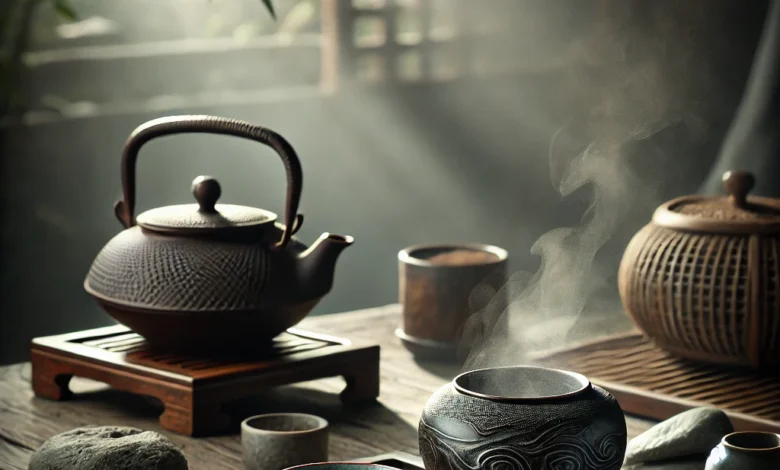Unveiling the History of Jian Zhan Tenmoku: Ancient Chinese Tea Art

Introduction: A Sip Into the Past
Tea is more than just a drink in Chinese culture—it’s a ritual, a conversation starter, a spiritual journey, and a symbol of harmony. Among the many treasures rooted in Chinese tea history, Jian Zhan Tenmoku teacups stand as both practical vessels and breathtaking works of art. These cups are not only revered for their striking aesthetics but also for the deep cultural significance they carry, having traveled centuries from ancient kilns to modern tea ceremonies.
When one delves into the world of traditional Chinese tea culture, Jian Zhan Tenmoku is a name that resonates with elegance, legacy, and sophistication. Originating during the Song Dynasty, these teacups were once the prized possessions of emperors and Zen monks. Crafted with an attention to detail that mirrors the contemplative nature of tea drinking, these vessels have become an enduring symbol of the fusion between utility and artistic expression.
A Glimpse of Ancient Brilliance
At the heart of this journey lies Jian zhan Tenmoku, a ceramic marvel whose history traces back over a thousand years to the Jianyang kilns of Fujian province. During the Song Dynasty (960–1279), tea was whisked into a frothy brew using powdered leaves, and the visual contrast of the vibrant green tea foam against the dark, lustrous glaze of Jian Zhan cups elevated the drinking experience into an art form. The aesthetics mattered just as much as the flavor, and Jian Zhan became the canvas upon which the beauty of tea was truly appreciated.
Their popularity soared within imperial courts and Buddhist temples, particularly among Zen monks, who found harmony in the natural patterns formed by the iron-rich glazes. The spontaneous, seemingly celestial patterns—often resembling oil spots, hare’s fur, or partridge feathers—reflected nature’s touch and spiritual calm. These patterns weren’t just visually appealing; they told stories of earth, fire, and the unpredictable grace of kiln alchemy.
The Unique Craftsmanship of Jian Zhan
Crafting a single Jian Zhan Tenmoku teacup is a meticulous process that combines ancient techniques with pure devotion. Clay is harvested from local Jianyang soil, which is rich in iron and minerals—key to the mesmerizing metallic glazes. Potters throw the clay by hand, shape it into elegant forms, and then apply specific glazes designed to react unpredictably in the intense heat of a wood-fired kiln.
The magic of Jian Zhan lies in its glaze. Fired at temperatures exceeding 1300°C, the glazes crystallize into stunning patterns that differ with every piece, making each cup one-of-a-kind. Some glazes result in a deep black hue with silver or gold specks, while others bloom into feather-like streaks that shimmer under light. The ancient Chinese potters believed this unpredictability was a divine gift—an expression of Daoist philosophy where spontaneity reveals the true nature of the world.
Why Jian Zhan Tenmoku Matters Today
Jian Zhan Tenmoku isn’t just about looking back—it’s also about reimagining the ancient in a modern context. As tea culture experiences a global renaissance, more enthusiasts are rediscovering the joy of sipping from a cup that’s been designed to heighten every sensory aspect of tea drinking.
Modern tea lovers are drawn to Jian Zhan not just for its heritage, but for its functionality. The unique properties of the glaze enhance the flavor profile of tea, allowing the true taste to shine through without being altered by the vessel. Additionally, the heavy and solid feel of the cup in hand promotes mindfulness—a grounding presence in our often chaotic lives.
More than just drinkware, these teacups invite a spiritual pause. Their connection to Zen Buddhism, where every act—no matter how mundane—is considered an opportunity for enlightenment, resonates with today’s mindfulness movement. Whether you’re practicing a traditional Gongfu tea ceremony or simply enjoying a quiet morning brew, Jian Zhan Tenmoku deepens the ritual with elegance and intention.
A Revival of Tradition
As Chinese ceramics continue to inspire artists and collectors around the world, Jian Zhan has found new admirers far beyond the borders of Fujian. This revival isn’t simply about nostalgia—it’s about preserving cultural integrity and sharing the soul of an art form that bridges nature, craftsmanship, and philosophy.
Today, a growing number of tea practitioners, potters, and historians are committed to reviving the traditional methods used to make authentic Jian Zhan. They return to the roots— sourcing the same clay, using wood-fired kilns, and following ancestral glazing recipes. This renaissance ensures that the legacy of Jian Zhan doesn’t fade into history, but continues to live on through the hands of modern artisans and the hearts of tea lovers.
Spiritual Symbolism and Zen Influence
The spiritual roots of Jian Zhan Tenmoku cannot be ignored. Deeply intertwined with Zen Buddhism, these cups were more than tools—they were meditative companions. In monasteries, monks would contemplate the mysterious patterns forming in the glaze, drawing parallels between the ever-changing surface and the transient nature of life.
The patterns themselves are symbolic. The “hare’s fur” design, with its long streaks, was said to resemble falling rain or light beams—reminding monks of impermanence. The “oil spot” pattern was likened to stars in a night sky, representing clarity amid darkness. These visual metaphors provided a silent dialogue between the observer and the universe, turning a simple tea session into a profound inner experience.
Timeless Design, Modern Appeal
Even from an aesthetic standpoint, Jian Zhan Tenmoku has aged gracefully. With minimalistic shapes and celestial patterns, the design fits seamlessly into both traditional and contemporary settings. Whether displayed on a rustic tea table or paired with a modern teapot, the cup exudes class and serenity.
Its universal beauty has caught the eye of designers and minimalists who appreciate the fusion of function and form. Owning a Jian Zhan isn’t just about drinking tea—it’s about owning a piece of living history, a vessel that bridges ancient and modern, East and West, spirit and substance.
Preserving Authenticity Through Practice
Understanding and appreciating Jian Zhan also means respecting its origins. As demand increases, so does the presence of mass-produced imitations that lack the spirit, quality, and craftsmanship of traditional pieces. True Jian Zhan artisans treat their work like sacred practice—every step infused with intention, patience, and honor toward the legacy they uphold.
This commitment to authenticity is what makes each piece valuable—not just in monetary terms, but in cultural and spiritual essence. Collectors and practitioners alike are encouraged to support this lineage by educating themselves and choosing pieces that reflect true craftsmanship.
A true appreciation of this art form leads us to support authentic craftsmanship and honor the deep history it carries with every sip. For those seeking genuine pieces and history, https://www.zenteacup.com/ offers a thoughtful gateway.
Conclusion: Beyond the Cup
Jian Zhan Tenmoku is more than pottery—it’s a philosophy shaped in fire and time. It speaks to the power of patience, the elegance of nature, and the importance of honoring one’s roots. Whether you’re a seasoned tea master or just beginning to explore the depth of Chinese tea culture, these teacups offer an intimate connection to centuries of artistry and wisdom.
As the world speeds forward, the quiet stillness of a Jian Zhan cup reminds us to pause. To feel. To reflect. And to drink deeply—not just from the cup, but from the well of history and soul it carries.



